Your film approaches the current and historic experience of Palestine through two animals, the rat and the donkey. Why this choice?
I did not choose two animals, I chose two discourses, two representations, two readings of the real through two authors. They are the ones to show these animals.
On the one hand Henri Laborit and the lab machine where rats are objects of knowledge, of science, of power; on the other hand Mahmoud Darwish, observant and observed by the donkey on the hill, the subjective, metaphorical, poetic animal.
You blend several types of visual and sound material, images, film or TV program scenes, archive from shoots… Which were the choices to rule their selection and combination? Why this “found footage” editing choice?
A lot of material has been produced about these subjects: the conflict in the Middle East, Palestine, Israel, the war, the two states, the colonization, the displacements, the genocide, Jerusalem, the territory, the sacred, etc… We can see the found footage like this, the gathering of of materials. Building signs that need other signs to be deciphered, re-staging what others have already done also works as an authorization in my sense.
Darwish has been one of the figures guiding me for a long time, at first with his voice because I did not learn Arabic as a child.
It is only very recently that the understanding of his journey, of his work as a promise, a fight and a symptom, came to me.
Discovering Laborit prompted something else. Who are we, with our personal stories, in the great wheel of History? In the places we are born and which assign us, draw us, free us, wreck us? The true and symbolic Middle East illustrates this conflict. Obviously I realize it now, but when I started the film, I only had the intuition that there was something to explore between the words escape and exile. From there on the whole aim of the film starts to make sense.
You give preponderant space to the text, in the form of a word, a phrase, or a fragment taken from the page. What are those texts, and why is such a space given to writing?
It feels evident that when you speak from authors, poets or philosophers or scientists or singers, the question of the texts is unavoidable. And there is also the meeting or the separation of voices and their subtitles, for example. (Re)leaving from the texts is of the same order as using preexisting images.
You approach the story of Palestine through its two most famous cultural figures, Mahmoud Darwish and Edward Said. But the evocation of its present is much more indirect and allusive. Why this central reference to the history of Palestine and its lost figures?
Regarding Palestine, which “present” should we talk about?
Since forever, I have heard about “the conflict in the Middle East” and “Palestine” is there. Others heard it before me, so for how many generations has this been the “present”? Crises come one after the other. There has been so many uproars… so many deaths, so many displaced, so much exile and destruction, and still these figures remain. These figures of hope and permanence. I find the figures summoned in the film to represent determined routes. They have never been restrained to “the history of Palestine” as you call it.
The work that has led me to present this film today started way before its “present” if you are referring to Gaza since October 7. This film is part of an artistic process where I invoke the universal despite its excesses and its traps, whose Orientalism critiqued by Said belongs to, precisely because it allows me to remove myself from the news and try to turn them against themselves.
I will admit I am perplexed when it comes to the space that works like this, only temporarily contemporary, can take up. I am interested in art as a critical tool, and in the end if this film has to have a role, it is to remind us of thinking while keeping in mind that it will not resolve anything.
I hope to work on a swerve, reanimating an emotion that concerns everyone.
Propos recueillis par Nathan Letoré
